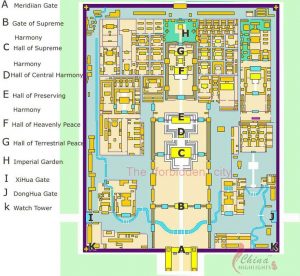How the Phenomenon of Diagonality Changed the Face of Modern Architecture
THE DARING DIAGONAL
CHAPTER TWO
THE RIGHT ANGLE
“Very early the square became an emblem of truth, justice and righteousness, and so it remains to this day, though uncountable ages have passed.”
SIR ISAAC NEWTON
BEDROCK ORIENTATION OF NATURE
What justified the steadfast faith in the right angle during the past seventy centuries of building construction? What was it about the right angle that contributed to its prevalence and veneration in building construction and site planning and why did it come into use before the use of diagonals? The answer to these questions is, somewhat surprisingly, gravity.
Figure 2.1 Gravitational lines of force fan out from the center of every cosmic body
Gravity is a fundamental force of nature whose very existence goes back to the dim origins of the universe. Gravity not only controls the motion of cosmic objects such as stars, galaxies and planets, it also affects all inorganic structures such as mountains, water, and tectonic plates. [Figure 2.1] Gravity holds the ocean in its seabed, leashes our atmosphere to the earth’s crust, carries rainwater down from mountain tops, and carries loose rocks from high ground to valleys. On habitable planets such as ours, gravity also affects the growth of plants and the movement of animals. It forces most plants and trees to rise in a predominantly vertical line toward light rather than at an angle. [Figure 2.2]

Figure 2.2 A commonplace stand of trees in Normandy, France.
In the world of microorganisms and cells, gravity surprisingly even affects their size relative to the force of the ambient gravitational field. In larger creatures, gravity shapes skeletal structure to allow for orderly and effective movement in air, sea, and on land. More unexpectedly, the right angle is embedded in electromagnetic phenomena. The force of magnetism for example runs perpendicular to an electric current. Even a photon traveling through space at the speed of light consists of complementary waves that run at right angles to each another. [Figure 2.3] Certain materials repelled by a magnetic field instantly align themselves at right angles to the field: a process known as diamagnetism.

Figure 2.3 Diagram of the complementary forces acting in a traveling photon of light.
It is not an overstatement to say that gravity is one of the most fundamental form-giving forces affecting all organic and inorganic structures on earth.
HUMANS AND GRAVITY
We humans cannot see the force of gravity itself but we react to it running through our bodies and see its effects in everything on the surface of the earth. If we stand leaning in one direction and then lean further, we topple over. One might say that our response to gravity is etched into the very marrow of our beings. We have an ingrained sense of what is upright when we stand up and unconsciously sense what is truly vertical or truly horizontal. A newborn looks into the face of its parent and sees an alignment of eyes, ears, and mouth that is perpendicular to the axis of the nose. [Figure 2.4]
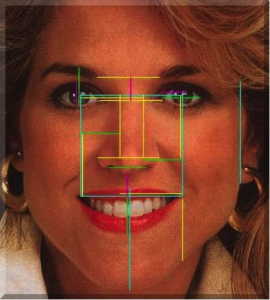
Figure 2.4 Perpendicular relationships in the structures of the human face.
So, too, with the axes of the shoulders and the hips as they relate to the central axis of the spine. [Figure 2.5] All these experiences and corporeal relationships contribute to our sense of perpendicularity and our appreciation of the right angle.

Figure 2.5 Perpendicular relationships in human body illustrated in this drawing by Leonardo da Vinci.
The consequence of this pervasive perpendicularity is that there are cells that exist along the route from eye to brain that respond only to energy pulses from vertical lines. Other cells respond only to horizontal lines, and still others discern only lines that have an oblique orientation. Moreover, for ambulatory creatures, it is not just the eyes that detect what is vertical and horizontal; the inner ear also sends warning signals when an animal is off balance and/or not upright. This vestibular system in the ears of humans and other animals provides a general sense of spatial orientation. It is also interesting that space seems to be pictured in the mind with its own quirky, innate frame of reference. For instance in our dreams, what we know to be vertical and horizontal orientations with eyes open are pictured as such even when we are lying on our side. This suggests that our mind-made images of verticality override our body-formed sense of what is upright…at least during sleep. One can speculate that this may be so because, although the body is prone, the inner ear (vestibular system) is still responsive to gravitational forces. These examples are meant to indicate the primacy of the force of gravity and that our deeply embedded sense of the horizontal and vertical are constitutive components of our consciousness.
In the exterior parts of the human body, perpendicularity and the concomitant right angle are obvious. For almost all organisms that move freely in their environment, whether in air, water, or on land, this symmetrical and perpendicular disposition of body parts to the spine is evident. Symmetry and motion are intimately and indispensably linked. That same sense of symmetry has forever been expressed in the design of buildings, whether the symmetry made sense or not.
Symmetry, in floor plan and facade, is an inherent characteristic and byproduct of perpendicular relationships and produces a quality generally regarded as beautiful. However, symmetry is oftentimes achieved at the expense of programmatic function. In a symmetrical building the space-needs in a wing to the right of a central axis are not usually the same space needs required in the wing on the left. Nevertheless, the desire for beauty and repose oftentimes overrides functional concerns. The desire for symmetry reinforces a predilection for right-angle construction.
RIGHT ANGLE and FOURSQUARE CONSTRUCTION
Although temporary structures such as tents, tepees, and yurts were circular, it was the right angle that dominated the geometry of permanent buildings throughout most of recorded history. Because right angles shaped countless individual rooms, by extension, it also molded the footprint of entire buildings into simple shoebox-shaped volumes, or combinations thereof. [Figure 2.6]
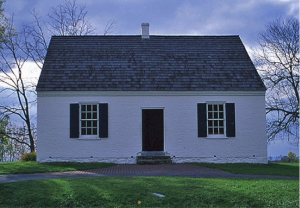
Figure 2.6 A Cape Cod style cottage
If one examines the floor plan of most buildings constructed prior to the twentieth century, particularly grand buildings such as the three story Elizabethan manor house called Longleat, and overlays the plan with a transparent film marked with graph-paper-like grid lines, it is certain the walls of the building will be parallel to the lines on the grid. [Figure 2.7] This geometry of right angles is called orthogonality.

Figure 2.7 Longleat, an Elizabethan manor house.
Also, throughout history, multiple buildings composing a single complex have often been arranged perpendicular to one another like the white tiles in the board game dominoes. The Forbidden City in Beijing, China is a fine example of this arrangement where not only is the footprint of individual buildings based on square corners but the orthogonal format also extends to the overall site plan of the complex; all buildings are set parallel to and/or at right angles to one another. [Figure 2.8] It is as if the use of square corners was predetermined by an immutable biological imperative lodged in the brains of the men who dressed the stones, cut the timbers, or drew the plans.
Figure 2.8 Site plan of the Forbidden City in Beijing, China
To achieve permanence and safety in construction, humans discovered long ago that walls must be built as close to plumb (vertical) as possible. [Figure 2.9] Signals sent from the inner ear, sensors in muscles and joints, and the functioning of the eyes indicated to a builder what was upright and therefore perpendicular to the mean level of the land on which he stood. The builder could sight by eye alone whether a wall ‘looked’ vertical. But this method was not perfectly reliable so builders discovered that hanging a heavy, arrow-shaped object, point down, from a string could precisely establish a vertical line: gravity in action This arrow-shaped object came to be known as a plumb bob and is still used today to determine if a wall is perfectly vertical. [Figure 2.9A] [Figure 2.9B] [Figure 2.9C]
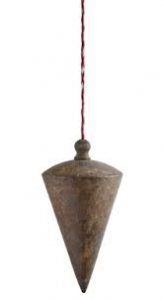
Figure 2.9 A Plumb bob.
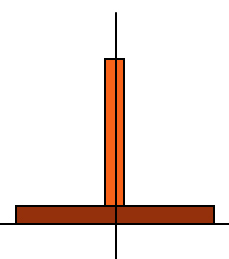
Figure 2.9 B Perpendicular construction
 Fig. 2.9C A wall is usually considered unsafe if it leans to such an extent that a plumb line passing through its center of gravity does not fall inside the middle one-third of its base (called the V-3 rule).
Fig. 2.9C A wall is usually considered unsafe if it leans to such an extent that a plumb line passing through its center of gravity does not fall inside the middle one-third of its base (called the V-3 rule).
For eons, foursquare construction resonated deep within builders on an unconscious level. It was appreciated but not understood that a force existed that held vertically positioned objects stable on the surface of the earth and brought leaning objects crashing to the ground. This inner sense of perpendicularity became a powerful symbol of the hidden order of things. [Figures 2.10]
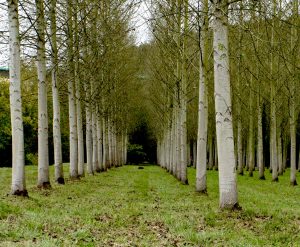
Figures 2.10 Tree plantation in Normandy region of France.
Although mysterious, here was an order of things that literally, figuratively, and structurally proved useful and enduring. [Figures 2.11]
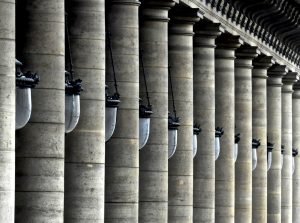
Figures 2.11 Colonnade in Paris, France.
Architects and builders also came to realize that walls that supported beams should be erected parallel to one another because it was more efficient to cut timbers and lengths of stone for the beams to a uniform length. This applied also to the end walls of a room, for if they were at something other than right angles to the supporting walls, the timbers at the end of the room had to be individually measured and cut to different lengths. Consequently, foursquare construction became the bedrock geometry of construction. [Figures 2.12]
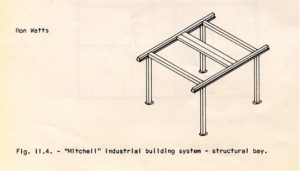
[Figures 2.12] A structural bay with uniform framing members producing a space with right angles.
Another factor favoring rectangular rooms is that cutting acute angles in stone is risky and unpredictable. To cut the end of a stone beam at a 45° angle requires much more time, energy and care than cutting it at a 90° angle because so much more material must be sawed through in the angled cut and breakage is possible at the sharp corner. Those sharp corners are also vulnerable to fracture by external assault or internal structural forces. Consequently, builders learned to avoid angle-cut beam-ends whenever possible.
There is only one way that one line can cross another in a two-dimensional plane resulting in all four angles being equal. That is for the two lines to be perpendicular, and this yields four 90° right angles. Prior to the 20th century, the physical and abstract elements of the right angle caused it to be the default geometry of building construction as exemplified for instance by the column and beam construction of structures such as the Temple of Chefren in Giza. [Figure 2.13]
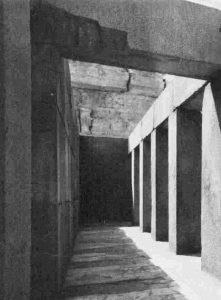
Figure 2.13 Giza, Valley Temple of Chefren.
There are also space-making advantages associated with the use of the right angle. If one views a rectangular room from above, it can be seen that the amount of enclosed floor area bears a critical relationship to the combined length of the four enclosing walls. In return for the shortest combined length of the four walls, the greatest amount of usable space is created. However, if one were to collapse the rectangle by making the angle of any two opposing corners obtuse (which makes the other two opposing corners acute, resulting in a diamond-shaped footprint, or parallelogram), the area of the enclosed space diminishes in proportion to the severity of the angles involved. [Fig 2.14]
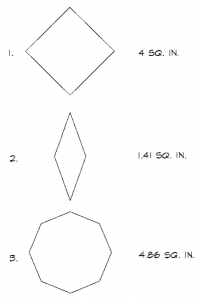
Fig 2.14 Plan of square, diamond-shaped room and octagonal rooms with calculations showing square footages for equal wall lengths.
It took little geometric intelligence to appreciate the fact that if the enclosing walls met uniformly at right angles, the greatest usable area would be enclosed for the most minimal constructional effort. Those who have studied geometry are aware, however, that polygonal shapes having more than four sides would have been more effective than rectangles in terms of maximizing interior space in relationship to the length of the enclosing walls. However, many ancient cultures were not geometrically advanced enough for these more challenging polygonal geometries to be employed in construction.
There were also symbolic advantages to using the right angle. An impression of permanence and stability were overriding concerns in ancient cultures such as Egypt. The soul’s eternal journey until it reunited with the body required a tomb that appeared capable of lasting forever. Additionally, royal power demanded temples that looked like they would stand eternally and never succumb to natural forces (such as earthquakes and windstorms), or to attacks by foes intent on domination or revolution. For these reasons, right angle construction with its stable and permanent appearance offered great symbolic value. Nevertheless, the Egyptians realized that a pyramid was the ultimate form associated with construction that could survive indefinitely and this involved merging roof and wall into a sloping plane. The footprint of a pyramid is square but its sky-facing planes are triangles. Two diagonals cross the square to form the triangular exterior surfaces.
Lastly, we turn to the economic advantages of using the right angle. In ancient Egypt, there was need for a way to parcel land to farmers and then later, after the rising waters of the Nile erased property lines, to redefine the parcel boundaries. The great Greek historian Herodotus had seen this flooding before the Egyptians had learned to tame the river with dikes, canals, and catch basins. He wrote, “When the Nile inundates the land, all of Egypt becomes a sea, and only the towns remain above water, looking rather like the islands of the Aegean.”

Fig. 2.15 Land division along the Nile in Egypt.
After each season’s flood the land was re-divided into a huge patchwork of perfect squares and rectangles with a precision that remains astonishing even today. [Fig. 2.15] Herodotus reported on the use of these squares and rectangles to compute a tax “This king divided the land…so as to give each one a quadrangle of equal size and…on each, imposing a tax. But [to] everyone from whose part the river tore anything away…he sent overseers to measure out how much the land had become smaller, in order that the owner might pay on what was left. In this way, it appears to me geometry originated, which passed thence to Greece.”
Paul Calter, in his book, Squaring the Circle: Geometry in Art and Architecture, suggests that “If flooding of the Nile symbolized the annual return of watery chaos, then geometry, used to reestablish the boundaries, was perhaps seen as restoring law and order on earth. We’ll see this notion again of geometry being sacred because it represents order, especially in the Middle Ages.” (Calter 2004)
THE ORTHOGONAL GRID
Among the earliest examples of right-angle construction are the “fortifications and partly excavated rectangular houses at Jericho that can be dated back to pre-pottery ages, and, according to carbon 14 testing, to between the middle of the sixth and the middle of the seventh millennium [BC].” [Gideon, 1964] P. 183. Further evidence of prehistoric right-angle construction are the postholes and trenches of the long timber houses, circa 5000 BC, in the area of Sittard, in the Netherlands.
Examples of complexes laid out according to an orthogonal grid are the Citadel of Sargon erected in 742 BC [Figure 2.16], and Persepolis, built in 518 BC, in what is now Iran.
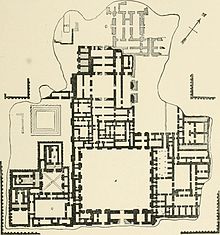
Figure 2.16 Plan of Palace of Sargon (a.k.a Dur-Sharrukin), Khorsabad (1905 reconstruction)
Another example of a single building in which the orthogonal grid is employed is a typical house built in India according to the tradition of Vatsu Shastra. [Figure 2.17] The required square plan of the dwelling consists of 81 squares, nine to a side. The center of the house, a courtyard consisting of nine squares, is likened to human lungs, and is therefore left open to the sky. [Figure 2.18] No ordinary daily functions occur in the courtyard; it is reserved for religious and cultural events.
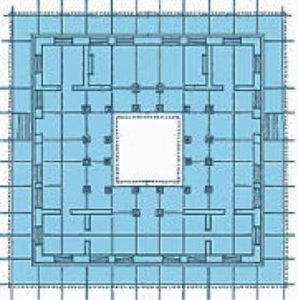
Figure 2.17 Indian house plan based on Vatasu Shastra tradition.
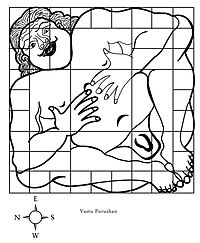 Figure 2.18 A Vatasu Pursha Mandala.
Figure 2.18 A Vatasu Pursha Mandala.
CONDITIONS INCOMPATIBLE WITH FOURSQUARE CONSTRUCTION
Although the large majority of buildings constructed throughout history have orthogonal plans, it should be noted that angled walls have appeared frequently in construction—but not by choice, not deliberately. Builders have been forced on occasion to distort the shape of an otherwise rectangular building in order to accommodate pre-existing site conditions such as a winding road or adjacent wall running angle-wise to the otherwise orthogonal geometry of the building or multi-building complex.
The Fortress of Uronarti, [Figure 2.19 A & B] built about 2,000 BCE illustrates how the overriding orthogonal geometry of a complex can, without design intention, include triangular rooms. But these triangular rooms occur as a mandatory response to pre-existing conditions. This 500 foot long fortress, that ‘became the prototype of most fortresses built in Europe and Asia during the next 3,000 years, reveals an orthogonal geometry that simply had to be ‘sliced off’ at an angle along the massive north wall. The geometry of the resulting angle-cut rooms does not otherwise influence the geometry of the rectangular spaces; they remain true to the orthogonal grid. It should be understood that Diagonality as treated in this treatise does not exist when a required accommodation to a pre-existing condition results in angularly truncated spaces.
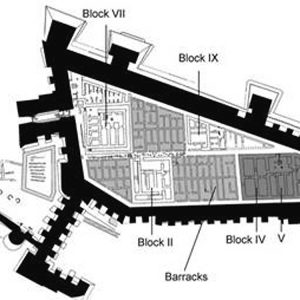
Figure 2.19A Ancient Egyptian Fortress of Uronati situated on an island in the Nile River. 19th C. BC
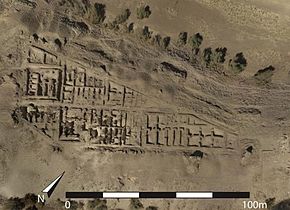
Figure 2.19A Arial view of actual Fortress of Uronati.
Constructing a building is different than creating an urban settlement. Organic urban settlements evolved through the accretion of individual buildings rather than by a plan drawn in advance. The accretion process occurs in a manner that is sometimes called haphazard or organic, but only because that is the way it looks. The typical medieval city might have originated at a spot along a river with flat banks, or on a hill with a great view or with defensible terrain, or at a particular dwelling where food or wares were sold or bartered. People were attracted to the site and arrived along routes that were scenic or easy to navigate. The footpaths became well-worn trails that wound around boulders and followed the contours in a hospitable or efficient manner. Structures were erected along these winding trails, and over time these structures formed a village. Buildings were erected along these winding routes that for the sake of efficiency and/or order, were composed of a combination of rectangles. However, their orthogonal geometry often yielded to pre-existing conditions, which more often than not were irregular, that is to say not orthogonal. These are examples of accommodation, not design intent. The architect or builder did not intend to design rooms with angled walls but passively responded to external conditions as illustrated by the photo of the angled corner in Paris. [Fig. 20] It would not have been uncommon for the angled wall to be thickened into a wedge shape so that on the interior, the square corners of rooms was preserved. [Fig. 21] Exceptions were the temple, the shrine, or the stand-alone special building that, free of the shape and orientation of adjacent structures and natural land features could utilize the right angle unencumbered.
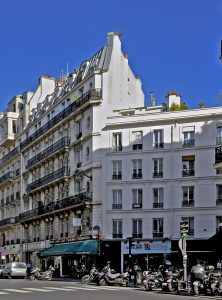
Fig. 20 An obtuse street corner in Paris, France, illustrating a non-orthogonal “collision” of adjacent buildings.
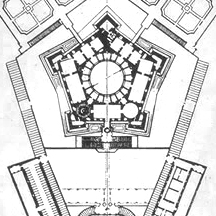
Fig. 21 Villa Franese at Caparola, Italy.
THE RIGHT LANGUAGE
In the English language, the words right and square pertain to both the right angle and to things that were deemed correct, good, or proper. Thus the right angle in construction was deemed good and came to be regarded as proper. Consider phrases such as, “please square that with me,” or “he’s on the right track,” or “she couldn’t be more right.”
Conversely, the word oblique, in addition to relating to relationships that were not orthogonal came to refer to things that were “not right,” “bad, questionable, or devious.” Consider these English language quotes.
1713 Steele Guard. No. 20 p.2 The oblique glance with which hatred doth always see things.
1770 Jortin Serm. (1771) I. vii. 128 There are persons to be found…who grow rich and great…by various oblique and scandalous ways.
The Masonic tradition has three definitions relating to the square: “(1) The conception of right angleness – our ritual tells us that the square is an angle of ninety degrees, or the fourth of a circle; (2) The builder’s tool, one of our working tools, the Master’s own immovable jewel; (3) That quality of character which has made ‘a square man’ synonymous not only with a member of our Fraternity, but with uprightness, honesty and dependability. The Masons regard the square as an emblem of virtue.”
It can be seen that language reinforced the validity and wholesomeness of the right angle and discouraged consideration of that which was oblique or angled. Consider the word upright. The origin of the word might come from the Old Testament Hebrew word transliterated as yashar. It means upright, straight, and level. It also means pleasing, correct, righteous and just. The origin of our English word upright is Germanic with subsequent variations in Old English, Dutch, German and English. As an adjective, the word means vertical, erect, perpendicular and plumb. But as it relates to a person or their behavior, the word is also taken to mean honest, honorable, upstanding, law-abiding, ethical, virtuous, principled, and noble.
On a more abstract level, the qualities of order, rationality, uniformity, and reliability associated with the right angle seemed almost god-given. Language reflected a preference for the word right and, as indicated above, imbued it with transcendent meaning including qualities such as being trustworthy, honest, reliable, loyal, steady, equal, substantial, and direct. Think of a square deal or a square meal.
Seen against this background, it is understandable that for eons, designs that were not square were shunned and avoided. Likewise, what was oblique and out of square was shunned, and words associated with things not square had a pejorative connotation.
What is interesting from a cultural perspective, however, is that as the modern world unfolded in the late 19th and 20th centuries, use of the word square now took on a new, not so favorable meaning, and this was in line with the changing zeitgeist of the modern era. As the rigid orthodoxy of past centuries began to erode, the honesty, clarity, and goodness associated with the word right, came to represent things that were rigid, stale, out of touch, constraining, conventional and unwanted. Phrases such as “be there or be square,” emerged. Other like phrases and meanings included: un-cool, not with-it, stuffy, old fashioned, and rigidly conventional. Throughout the Twentieth century, for a variety of reason to be set forth later in this book, architecture rooted in the right angle and the orthogonal grid slowly began to loose favor in certain circumstances and more adventurous designers were turning to the daring geometric motif of the diagonal and the oblique.
In summary, it is clear that throughout history, the right angle was enthusiastically embraced in the construction of buildings for multiple reasons: (1) It created stable structures; (2) It was easy and efficient when cutting and joining structural members; (3) It was also useful in setting out plots of land, calculating the taxes on the those plots, and reestablishing the borders after a flood; (4) The architectural spaces created were simple, open, and functional.

